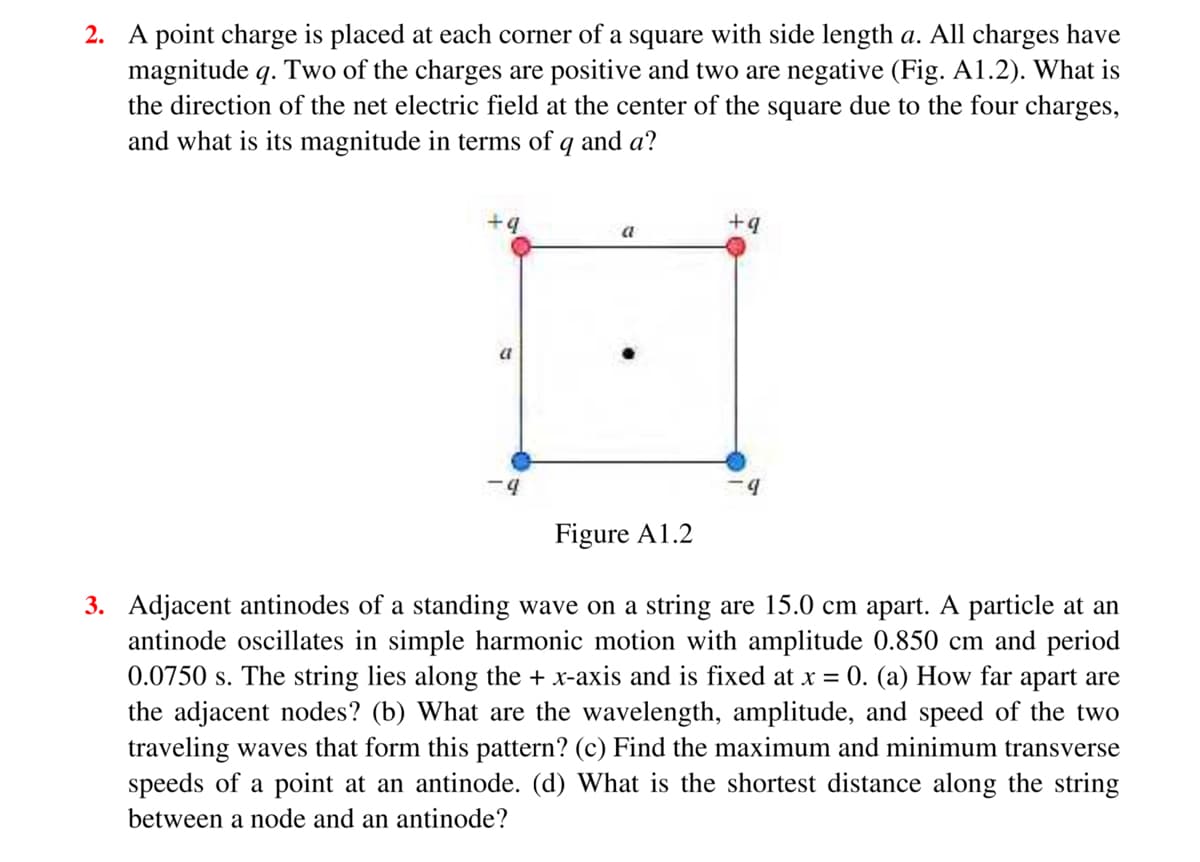A point charge is placed at each corner of a square with side length a. All charges have magnitude q. Two of the charges are positive and two are negative (Fig. A1.2). What is the direction of the net electric field at the center of the square due to the four charges, and what is its magnitude in terms of q and a?
A point charge is placed at each corner of a square with side length a. All charges have magnitude q. Two of the charges are positive and two are negative (Fig. A1.2). What is the direction of the net electric field at the center of the square due to the four charges, and what is its magnitude in terms of q and a?
Principles of Physics: A Calculus-Based Text
5th Edition
ISBN:9781133104261
Author:Raymond A. Serway, John W. Jewett
Publisher:Raymond A. Serway, John W. Jewett
Chapter24: Electromagnetic Waves
Section: Chapter Questions
Problem 28P
Related questions
Question

Transcribed Image Text:2. A point charge is placed at each corner of a square with side length a. All charges have
magnitude q. Two of the charges are positive and two are negative (Fig. A1.2). What is
the direction of the net electric field at the center of the square due to the four charges,
and what is its magnitude in terms of q and a?
b.
+q
a
a
b.
Figure A1.2
3. Adjacent antinodes of a standing wave on a string are 15.0 cm apart. A particle at an
antinode oscillates in simple harmonic motion with amplitude 0.850 cm and period
0.0750 s. The string lies along the + x-axis and is fixed at x =
the adjacent nodes? (b) What are the wavelength, amplitude, and speed of the two
traveling waves that form this pattern? (c) Find the maximum and minimum transverse
speeds of a point at an antinode. (d) What is the shortest distance along the string
0. (a) How far apart are
between a node and an antinode?
Expert Solution
This question has been solved!
Explore an expertly crafted, step-by-step solution for a thorough understanding of key concepts.
Step by step
Solved in 2 steps with 2 images

Knowledge Booster
Learn more about
Need a deep-dive on the concept behind this application? Look no further. Learn more about this topic, physics and related others by exploring similar questions and additional content below.Recommended textbooks for you

Principles of Physics: A Calculus-Based Text
Physics
ISBN:
9781133104261
Author:
Raymond A. Serway, John W. Jewett
Publisher:
Cengage Learning

Physics for Scientists and Engineers, Technology …
Physics
ISBN:
9781305116399
Author:
Raymond A. Serway, John W. Jewett
Publisher:
Cengage Learning

Physics for Scientists and Engineers: Foundations…
Physics
ISBN:
9781133939146
Author:
Katz, Debora M.
Publisher:
Cengage Learning

Principles of Physics: A Calculus-Based Text
Physics
ISBN:
9781133104261
Author:
Raymond A. Serway, John W. Jewett
Publisher:
Cengage Learning

Physics for Scientists and Engineers, Technology …
Physics
ISBN:
9781305116399
Author:
Raymond A. Serway, John W. Jewett
Publisher:
Cengage Learning

Physics for Scientists and Engineers: Foundations…
Physics
ISBN:
9781133939146
Author:
Katz, Debora M.
Publisher:
Cengage Learning